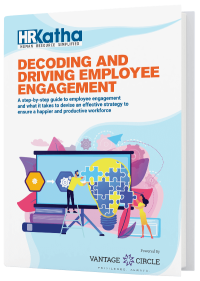The Right Ways to Measure Employee Engagement Remotely

Finding the right ways to measure employee engagement and improving it is a common struggle amongst companies and their HR managers. Now, more than ever, when organizations are forced into working remotely due to the ongoing Covid-19 pandemic, understanding the importance of employee engagement has become the key to a successful business.
Management thinker Peter Drucker is often quoted as saying that
“You can’t manage what you can’t measure.”
Therefore, this article is carefully curated to bring you the right ways to measure employee engagement remotely.
But first, let us quickly get into what employee engagement is. There is no clear definition, and it can differ from company to company and employee to employee. This is the reason why measuring engagement can be a tough job.
- Some organizations define it as happiness,
- Some describe it as satisfaction,
- While others define it as a commitment to goals.
However, long story short, employee engagement can be termed as "the emotional connection which an employee feels towards his or her organization, that tends to influence their behaviors and level of effort in work-related activities."
To know about Employee Engagement in detail, read: What is Employee Engagement? Levels, Benefits, Drivers
Remote workers care about employee engagement too!
Slack found that 85% of workers want to feel closer to their remote teams. But the effects of detachment aren't limited to interoffice relationships. Employee engagement takes a hit too.
There is a vast difference between employees working in the workplace and working at home or remotely. Remote employees and employers have been facing various challenges of engagement and productivity at work due to this shift, for which no one was prepared.
Remote work has its own benefits , but the various disadvantages can lead to disengaged employees.
It is much more convenient to measure and improve employee engagement when the employees and the employers or HR managers can have face-to-face interaction. And work together at a shared workplace.
But measuring employee engagement remotely is a relatively new concept. It has become necessary for managers to find remote or socially distant ways to keep employees engaged, which will lead to personal and professional success. Otherwise, disengaged remote employees will do more harm than good to the organizations.
Now the question arises. What are the right ways to measure employee engagement remotely?
My answer would be to create various “communication channels.” Managers need to develop multiple ways to communicate with employees, keeping in mind the various necessities of remote employees to obtain the best results.
So, let’s dive into the various ways managers can measure employee engagement for a remote team.
7 proven ways to measure employee engagement remotely
1. Employee engagement surveys
There are various tailored surveys and tools to test the engagement levels of the employees. One of the most common surveys is the "Pulse survey". It's short, frequent, and can be conducted at regular intervals of time. It consists of 10-15 questions on employee satisfaction, job role, communication, relationships, and work environment.
There are various cloud-based survey platforms, which prove to be well-fitted for surveying remote employees. One of them is our very own Vantage Pulse .
Managers can also send out various other surveys that explore employee experience and employee happiness in greater depth.
Benefits of employee engagement surveys are:
- Well-fitted for remote employees as most surveys can be made into a cloud-based platform
- Creates awareness among employees as well as managers
- Creates a culture of feedbacks
- Real-time data
2. Daily scrums/Stand-ups
Daily scrums or stand-ups are regular team meetings that managers can host with team members of various departments.
These meetings are generally held at the beginning of a working day. Employees need to provide a quick update on their progress at work and their goals for the rest of the day.
Remote employees or their managers can connect through various video conferencing platforms like Zoom or Skype for these meetings.
Benefits of daily scrums/stand-ups are:
- Managers get an overview of the day-to-day activities, progress, and level of engagement of employees
- It helps employees set goals for themselves
- Employees have a clear view of the day and the work that needs to be done
3. 1-On-1s
Managers and remote employees can connect through various video call platforms or through calls for conducting one-on-one meetings. These meetings can also be held between members of the same team.
Employees working from home or remotely might face various challenges, which might lead to disengagement in work. These challenges need to be addressed or talked about to run the organization smoothly.
One-on-one meetings are a great way to measure engagement and employee personality and help individuals develop professionally and understand their challenges and strengths.
Benefits of 1-On-1s:
- Get a clear view of the individual development of each employee
- Support employees with the challenges that they face individually
- It helps uncover your employees' personal goals and objectives, and you can try to align them with the organizational goals.
- Keep track of these meetings and employees’ progress and engagement at work.
4. Hold focus groups
In an employee focus group, employees take part in a guided discussion on a particular topic. About 33 percent of organizations use focus groups to determine the level of engagement their employees have.
Focus groups are most effective when combined with other research methods, such as interviews, pulse surveys, and employee surveys. This helps businesses to utilize both quantitative data as well as qualitative insights.
Employees are asked questions, including asking workers if they feel their work is vital to the company and whether they have the tools to do their jobs effectively. These types of questions help in measuring the engagement levels of employees.
Managers can convene focus groups online for remote employees and gather six to 12 employees together to talk.
Benefits of holding focus groups:
- Focus groups can be tailored to different situations and circumstances, meaning they offer a flexible solution for businesses.
- Arranging focus groups can be a quick and resourceful alternative.
- It can reveal insights quickly that can lead to further research methods subsequently.
- It can allow participants to explain further and express the reasons behind their behaviors, motivations, and feelings.
5. Stay/Exit Interviews
Exit interviews are a common practice at most organizations. These interviews are a great opportunity to measure why some employees find it difficult to engage in work. Exit interviews are most helpful to get honest feedback about your company. These individuals are likely to be comfortable speaking openly when their job isn’t at stake.
On the other hand, at stay interviews, managers ask employees who are happy at work what makes them want to stay.
With remote employees, these interviews can be done through surveys, emails, and video conferences.
6. eNPS
eNPS stands for Employee Net Promoter Score. It is a metric used by companies to gauge employee satisfaction with their employment experience. It is one of the most successful ways to measure engagement.
eNPS measures how likely your staff members are to recommend your company as a place to work. It asks employees how likely they are to ‘promote’ you on a scale from 0 to 10.
Most employees nowadays prefer working from home, and many organizations are taking steps to go remote. eNPS can be a great way to measure if your remote employees are engaged enough. Or have good employee experience at your organization to recommend you to work remotely to find remote jobs.
Benefits of the eNPS measure:
- It truly gauges loyalty
- Ease of calculating the results and the ability to benchmark it
7. OKRs
Google likes to set OKRs such that success means achieving 70% of the objectives, while fully reaching beyond the set goals is considered extraordinary performance. It becomes a lot easier to measure success and how the employees are engaging in their work.
OKR means Objective Key Results. OKR check-in is a monthly or annual meeting that can stretch from 20 minutes to an hour. Teams reflect on the progress at work and set new goals for the upcoming month or year at these meetings.
The goal is to ensure everyone goes in the same direction, with clear priorities and constant rhythm. An OKR can be termed “a set of metrics that measure an employee’s progress and engagement towards the objectives set.”
OKRs have proved to be very helpful for managers working with remote teams. Holding OKR check-ins on video-conference with all the remote workers has made it easy for managers to keep track of every team’s objectives, performance, progress, and engagement towards work and the organization as a whole.
Benefits of holding OKRs:
- It helps create alignment in the organization
- It helps connect employees’ work to a company’s mission–this impacts employees’ performance and your company’s results.
- OKRs bring transparency to your company. Everyone sees what others are working on, driving collaboration and better performance.
What's Next?
William Kahn, the founding father of engagement, said,
I define personal engagement as the harnessing of organization members' selves to their work roles; in engagement, people employ and express themselves physically, cognitively, and emotionally during role performances.
Employees are the backbone of an organization, and engaged employees are the path to success. Measuring employee engagement proves very beneficial for any organization. But it can be a challenging task.
But the more challenging task is to work upon the data collected and try to understand every perspective. The steps next would be to:
- Analyze the results
- Map out a plan
- Communicate with employees
- Reassess and replan
The takeaway from this article would be to consider the various needs and difficulties that remote employees might face and plan out measuring engagement strategies likewise. But first, try out the above strategies and let us know if it works for you.

Vantage Circle is a simple AI-powered Rewards & Recognition Platform for upgrading your employee experience and engagement for better productivity.






